They say… 
Best beer and travel writing award 2015, 2011 -- British Guild of Beer Writers Awards
Accredited Beer Sommelier
Writer of "Probably the best book about beer in London" - Londonist
"A necessity if you're a beer geek travelling to London town" - Beer Advocate
"A joy to read" - Roger Protz
"Very authoritative" - Tim Webb.
"One of the top beer writers in the UK" - Mark Dredge.
"A beer guru" - Popbitch.

|
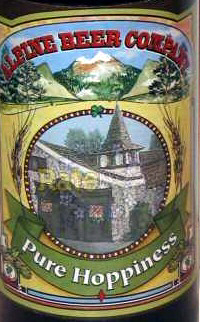 Alpine Pure Hoppiness. Best Damn Beer Shop
ABV: 8%
Origin: Alpine, California, USA
Website: alpinebrewing.com
When you think about it, “Pure Hoppiness” is such an obvious punning name for a hop-focused beer, it’s surprising someone didn’t grab it years ago. Instead, it’s fallen to a very small but high achieving craft brewery in the rural reaches of San Diego County to apply the term to one of its signature beers, an outstanding example of a West Coast double IPA.
Brewing brothers Patrick and Shawn McIlhenny, who founded Alpine in 2002, are cagey about the exact ingredients and IBUs of Pure Hoppiness, but do disclose that double the normal quantity of hops is added on the boil, with more in the hopback followed by two sessions of dry hopping, the later one with the addition of oak chips. An even hoppier companion beer, Exponential Hoppiness, has since been added, though I prefer this better balanced example.
My sample, a 65cl (22oz) bomber bottle bought from the Best Damn Beer Shop in downtown San Diego, poured a hazy warm gold with a yellow-tinged head and a very piny, slightly savoury aroma layered with tropical fruit. I detected a faint hint of diacetyl – sometimes regarded as a flaw for an IPA but in this case restrained enough not to detract from the clean fruity hop character.
Hophead beers of this kind can so easily fall into the trap of presenting an aggressive cacophony of bitter resins from the start, but the best examples reward the patient drinker by revealing their riches over successive sips, and Pure Hoppiness is no exception, unfolding a succession of layers of hoppy delights on the palate while remaining lively and cheerful.
Smooth mint toffee and pine kick things off, with firm rooty hops emerging over the support of chewy malt, and even a hint of coffee. A long, very full and bittering finish crackles with rooty, herbal hop flavours, white grapefruit and a dash of mint.
Alpine is a small town so named because it reminded a 19th century resident of Switzerland. Its eponymous brewery has given the place a new peak to admire.
 AleSmith Wee Heavy Scotch Style Ale Best Damn Beer Shop
ABV: 10%
Origin: San Diego, California, USA
Website: www.alesmith.com
I first heard about the buzz around beer in San Diego from some itinerant locals who struck up a conversation with me at Belgium’s Zythos Bierfestival in 2008. They also very kindly gave me a bottle of AleSmith’s celebrated Speedway Stout, which placed one of the city’s numerous highly admired breweries firmly on my map.
Like many new US craft breweries, AleSmith – in the northern suburbs of San Diego not far from the US Marine Corps air station at Miramar – is firmly rooted in the homebrewing movement. Founded by home brewers Skip Virgilio and Ted Newcomb in 1995, it was bought out in 2002 by another home brewer, Peter Zien, also an experienced beer judge, though brewer Tod Fitzsimmons, who has been there almost since the beginning, remains a major influence on the products. The preference is for strongish beers in big, smart bottles that are especially bold and distinctive even by southern Californian standards.
Wee Heavy, originally named J P Gray’s Wee Heavy after co-founder Skip Virgilio’s grandfather, was a relatively early American craft foray into the 90/- style of strong Scottish ale that is now all too rare in its homeland. It’s since become recognised as something of a benchmark, with several awards to its credit.
The beer derives colour and character from dark roasted malt, pouring a rich deep ruby brown with a fine yellowish head. A smooth, winy, slightly woody and chocolatey aroma has notes of rich raisin-tinged malt.
The palate is also full, smooth, rich and winy, but notably dry, balanced by roasted malt, more woodiness and generous hops lending bitter herb and fruit notes. A long and warming finish has bitter herbs, chocolate, a burr of roast malt and tannic cherry-inflected wood. Overall it’s an outstanding example of how US craft brewers have reinterpreted endangered European styles with flair.
My notes are based on a 750ml bottle from City Beer in San Francisco.
 Your author sampling the wares at the Borefts Bierfestival, Bodegraven, Netherlands, September 2012. Pic: Stephen Robinson. 2012 was another great year for tasting beer. Britain’s brewers got ever more eclectic and adventurous, and London’s share of good breweries and top venues multiplied apace. The developing Belgian scene was well reflected in the newly expanded Zythos Bierfestival. My first visit to the Borefts festival at De Molen in the Netherlands amply satisfied my geekiest cravings, while trips to San Diego and to San Francisco again yielded more delight from the ever-growing Californian scene, including some fine new session beers. I also took the opportunity to return to some well loved classics.
For the fifth year running, I’ve tried to whittle the many hundreds of beers I sampled during 2012 down to 30 examples that between them best demonstrate why liquids fermented from cereals are worthy of my and your time, energy and enthusiasm. It’s difficult to say whether they’re the absolute best of the year, but they’re ones that particularly stuck in my mind, and together provide a broad palette of styles and taste sensations, with a limit of one beer per brewer.
Compiling this list never gets any easier, so for the second time I’ve resorted to appending some additional honourable mentions. Both lists are in alphabetical order, with no further ranking intended, and the clickable links will take you to detailed tasting notes and background information.
- Adnams Southwold Bitter 3.7% Southwold, Suffolk, England
- Anchor Porter 5.6% San Francisco, California, USA
- Arbor Brigstow Bitter 4.3% Bristol, England
- Batemans Combined Harvest 4.4% Wainfleet, Lincolnshire, England
- Budějovický (Budweiser) Budvar 12° nefiltrované 5% České Budějovice, Jihočeský Kraj, Czech Republic
- Coniston No 9 Barley Wine 8.5%Coniston, Cumbria, England
- Deschutes/Hair of the Dog Conflux No 1 Collage 11.6% Bend, Oregon, USA
- Dying Vines/Linden Street Dee’z English Mild 4% Oakland, California, USA
- FiftyFifty Eclipse Imperial Stout White Wax 2011 9.5% Truckee, California, USA
- Fuller’s Past Masters Old Burton Extra 7.3% London W4, England
- Girardin Gueuze 1882 (Black label) 5% Sint-Ulriks-Kapelle, Vlaams-Brabant, Vlaanderen
- Greene King Old 5X 12% Bury St Edmunds, Suffolk, England
- Heineken Italia Moretti La Rossa 7.2% Milano, Lombardia, Italy
- Ilkley Siberia 5.9% Ilkley, Bradford, England
- Jester King Le Petit Prince 2.9% Austin, Texas, USA
- Knee Deep Simtra Triple India Pale Ale 11.3% Lincoln, California, USA
- Le Brewery Odo 6.6% Joué du Bois, Orne, France
- Marble/Emelisse Earl Grey IPA 6.8% Manchester, England
- Maximus Stout 6 6% Utrecht, Netherlands
- Mikkeller/Proef Big Bad Worse Barley Wine 12% Lochristi, Oost-Vlaanderen
- Oskar Blues Old Chub Scotch Ale 8% Longmont, Colorado, USA
- Panil Barriquée Sour 2012 8% Torrechiara, Emilia-Romagna, Italy
- Rodenbach Grand Cru 6% Roeselare, Oost-Vlaanderen
- Russian River Pliny the Elder 8% Santa Rosa, California, USA
- Schneider Tap X Mein Nelson Sauvin 7.3% Kelheim, Bayern, Germany
- Shepherd Neame India Pale Ale 6.1% Faversham, Kent, England
- Ska Steel Toe Working Class Milk Stout 5.4% Durango, Colorado, USA
- Societe The Pupil 7.7% San Diego, California, USA
- Tempest Brave New World 7.8% Kelso, Scottish Borders, Scotland
- Weihenstaphaner Vitus 7.7% Freising, Bayern, Germany
Honourable mentions: 3 Fonteinen Faro, Alpine New Millennium, Augustiner Maximator, Beeston Norfolk Black, Borgo L’Equilibrista, Clarence & Fredericks Best Bitter, Driftwood Spars Alfie’s Revenge, Ducato The Masochist, Durham White Stout, Evil Twin/ Fanø Hey Zeus!, Faust Auswandererbier 1849, Firestone Walker Walker’s Reserve, Heretic Shallow Grave Porter, Jandrain-Jendrenouille VI Wheat, Kernel Export India Porter Bramling Cross, Lion à Plume/Bastogne Pastiche, Logsdon Seizoen Bretta, Lover BeerBera, Magic Rock Bearded Lady Bourbon Barrel, Molen Bommen & Granaten Cascade BA, Nethergate Nicholson’s Lamplighter, Plain Incognito Port Stout, Port/Lost Abbey Red Poppy Ale, Ranke Saison de Dottignies, Redwillow Soulless, Seef/Roman Antwerpse Seef Bier, Senne Zinnebir, Tap East 3 Shades of Black: The barrel-aged, Williams Brothers Nollaig, Worthington Czar’s P2 Imperial Stout.
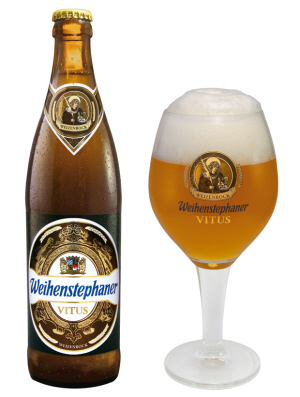 Weihenstephaner Vitus Top Tastings 2012
ABV: 7.7%
Origin: Freising, Bayern, Germany
Website: www.weihenstephaner.de
My 2012 top tastings feature not just the brewery that claims to be Britain’s oldest (Shepherd Neame), but the one that claims to be the world’s oldest too. Weihenstephan, or ‘Holy Stephen’, began brewing as a Benedictine monastery in Freising in Upper Bavaria, now part of the metropolitan area of München. The brewery’s quoted of founding date of 1040 is that of the first known brewing license, though the monks may have been making beer before that.
In 1803 the monastery was secularised by Napoleon but brewing continued on the site under the auspices of the State of Bavaria. Since 1923, it’s operated simultaneously as a working commercial brewery and one of the world’s leading brewing schools, run in partnership with the Technische Universität München.
Though it also brews lagers, Weihenstephan is arguably most famous for its wheat beers, and Vitus, added to the range as recently as 2007, is its big, beefy Weizenbock. Named after a 4th century martyred saint, it tastes appropriately like a decent everyday Bavarian wheat beer racked up several notches in strength and impact.
The beer is a delicate yellow with a massive white head and a complex aroma with plenty of tempting cereal, clove, bubblegum and light creamy hops. The palate is reminiscent of a clove spiced apple crumble dished up with custard, with candyfloss notes, a beautifully rich and fluffy mouthfeel and notable hop bitterness for the style. Similar flavours play on a mouth coating and long lasting finish, with complex fruit, chewy hops and more custard and vanilla spice.
My bottle came from a selection of spares left after judging 2012’s World Beer Awards – where the beer ultimately won World’s Best Wheat Beer, having scooped World’s Best Beer overall the previous year.
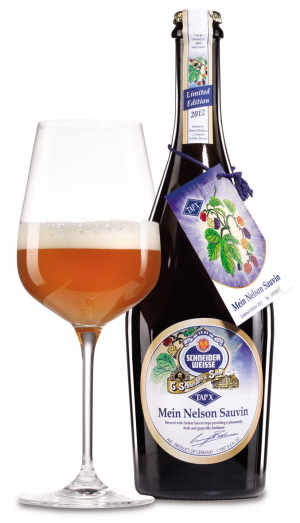 Schneider Weisse Tap X Mein Nelson Sauvin. Top Tastings 2012
ABV: 7.3%
Origin: Kelheim, Bayern, Germany
Website: www.schneider-weisse.de
Of all the great European brewing industries, Germany’s seems the most conservative, complacent and insulated from international trends. Many of the country’s vast numbers of brewers still seem to think no further than their immediate distribution area, whether that’s a region or a village, with little recognition that the world at large is interested in their traditional beers, let alone that brewers beyond that area might have the occasional good new idea from time to time.
In an era where brewing is becoming increasingly globalised, and polarised between an innovative and dynamic craft sector on the one hand and a blanded out, marketing driven mainstream dominated by aggressive multinationals on the other, it’s an attitude that doesn’t bode well for Germany’s much-prized focus on quality.
Thankfully there are some shining examples of German brewers who’ve, so to speak, woken up and smelt the hops, and one of them is Schneider in Kelheim – possibly the most revered producer of traditional Bavarian weissbier.
The brewery hasn’t messed with any of its textbook brews, but it’s responded to interest in export markets by stretching the boundaries of the style with a series of occasional specials, devised by head brewer Peter Drexler and chief executive Georg Schneider VI. All Schneider’s regular brews are now giving “tap” numbers – for example its legendary dark Weissbock Aventinus is designated Tap 6 – and the new beers are pegged as Tap X.
The first experiment was prompted by a request from ABT (Alliantie van Bier Tapperijen), the Dutch association of specialist beer pubs, for a special to celebrate its 25th anniversary in 2011. Far sightedly, the brewery focused on hops, creating a fine strong golden wheat beer which, remarkably for Germany, featured the New Zealand varieté du jour, Nelson Sauvin.
Tap X Mein Nelson Sauvin was a great success not only in ABT pubs but in the US and other export markets – and, interestingly, at home in Germany too. “Public taste has noticeably evolved,” observed Georg. So the beer made a return appearance in 2012, and I wouldn’t be surprised to see it again before long.
The use of an exotic hop has enabled the production of an innovative beer that still complies with traditional purity requirements, otherwise sticking to a grist of barley and wheat malt. One other unusual (and international) touch, though, is the use of a second yeast from Belgium for bottle conditioning.
I bought my elegant 750ml bottle of the 2012 version, number 7843, from Utobeer in Borough Market. It poured a deep and cloudy yellow with a typical thick and creamy wheat beer head. The aroma, though, wasn’t typical – although subtle, the grape and spice character of the hop was evident alongside a slightly tannic note and the more accustomed Weissbier whiffs of cream and banana.
A very intriguing creamy, spicy and fruity palate had more grape notes – muscat rather than sauvignon blanc – and spicy tangerine flavours. The apple, apricot and grape finish had building bitter notes, with more hop bitterness than is usual in the style, finishing with plenty of creamy cereal and seedy, spicy tones.
It’s not only an excellent beer, but a fine example of how a great historic brewery with deeply rooted traditions can respond to those evolving tastes without chucking out what made it great in the first place.
For a brief note on the history of the brewery see my 2007 review of Schneider Weisse.
 Tempest Brave New World Top Tastings 2012
ABV: 7.8%
Origin: Kelso, Scottish Borders, Scotland
Website: www.tempestbrewingco.com
In May 2012 I hosted an IPA tasting downstairs at Mason & Taylor in Shoreditch – one of my favourite new craft beer bars in London until BrewDog made them an offer they couldn’t refuse. Manager Steve Taylor recommended including this example, from a great new brewery in the Scottish Borders.
Historically Scotland is associated in most people’s minds with sweet beers employing relatively little hops, but in the 19th century the country was a major producer of India Pale Ales, with Edinburgh in particular once exporting at least as much to the subcontinent as Burton upon Trent.
Tempest was opened in 2010 by former chef Gavin Meiklejohn, a Scot with an international perspective from working in New Zeland and at the Whistler brewery in British Columbia. Returning to Scotland, he ran the Cobbles Inn in Kelso before getting his own brewery together with Allan Rice, formerly of the Stewart brewery in the capital.
Brave New World signals its contemporary transatlantic inspirations in its name, and includes New Zealand and US hops in its recipe. It pours a hazy warm amber with a thick yellowish head. The aroma is packed with fruit – grapes, figs, mangoes, apricots – but smoothed by the underlying grain.
The palate has a firm underpinning of digestive biscuit and toast with a slightly sticky residual sweetness, a platform for fruity swathes of strawberry and mango and a touch of menthol toffee. A dark and biting finish reminded me of burnt apricot tart, with those notes of menthol returning alongside lettuce bitterness.
It’s a long stretch from the high industry of Victorian Edinburgh to an artisanal setup in the small town of Kelso, but I’d hazard that, well resourced Aberdonian punks notwithstanding, this is currently the best example of the style brewed in Scotland.
 Beers and brewhouse at Societe Brewing, San Diego CA. Top Tastings 2012 (The Pupil)
ABV: 9.8%, 6% and 7.7%
Origin: San Diego, California, USA
Website: www.societebrewing.com
San Diego, a naval and university city in California’s far southwestern corner, is also a top craft beer producer, boasting heavy hitters like AleSmith, Port and Stone in the immediate vicinity. But there’s clearly still room for more, particularly when they’re as fresh and vibrant as Societe, with its smart new brewhouse and taproom among malls and light industry in Kearny Mesa, just off a freeway in the northwest of the city.
Societe – it’s tempting to pronounce it French-style but apparently you just say “society” – was set up in 2011 by Travis Smith and Doug Constantiner, who got together while both working at the Bruery in Placentia, though Travis gained previous brewing credentials at Russian River.
The range of styles is no longer any great surprise in Californian brewing – modern hoppy pale ales on the one hand, big Belgian-inspired monsters on the other. A collection of refill oak casks is already stacking up beside the cylindroconicals. But the considerable subtlety and deftness of touch with which those styles are executed marks Societe out as one to watch. So do the slightly puzzling names with their obligatory definite articles, which make any list of their beers read like the title of something on the Booker Prize shortlist.
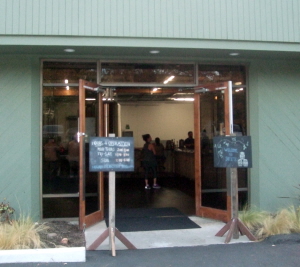 Welcome to Societe. There are a few surprises too. Reflecting the growing interest among US craft brewers in more everyday beers, The Harlot was inspired by Westmalle Extra, brewed at the West Flemish Trappist brewery for the monks’ own consumption though occasionally bottled and sold commercially. I’m not sure if there’s any satirical intent in giving a monastic-inspired brew such a provocative name, but it might raise an eyebrow among the Fathers.
At 6% the beer is still rather pumped up from the 4.8% of its inspiration, but it shares the latter’s subtlety and easy drinking character. It’s a golden beer with a fine white head and a light coriander accent to a spicy, flowery, creamy and very authentic aroma, with notes of waxy honey and spice.
A smooth lemony palate has grass, spiced orange, roses and violets, with light and gentle but fresh hops taking over in the finish. There’s perhaps just a little too much sweetness to make it truly refreshing but it’s a decent brew nonetheless.
More typically immense and Californian, though reassuringly well-integrated, is imperial stout The Butcher, a serious dark mahogany beer with a lacey brown head staining the glass yellow. There are already some autolysed gravy notes in a dark, intense and ashy aroma, with an emphasis on roasted grain yielding little fruit.
The huge and slightly phenolic palate has cocoa syrup, roast and tingling hops with an emerging fresh tropical fruit touch, dominated by coffee flavours. The finish is warmly alcoholic but stays smooth, with piny rooty hop resins on the tongue, hints of mature cheese around the edges, and thick cocoa bubbling like larva all over. Grapes and tropical fruit make a late reappearance.
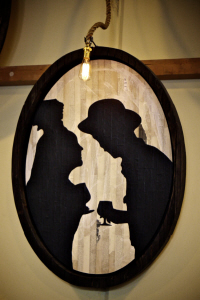 Tasteful decoration at Societe, San Diego, CA. Pic: Sally Monster. Used under license. There are several pale ales that share an approach to hopping favouring aroma and fruitiness over too much bitterness, and all those I tried were cheerful and interesting. Two IPAs were on offer when I called – The Apprentice and its milder counterpart The Pupil. And while I rated both highly, the latter was just my favourite.
It’s a hazy light yellow beer with a fine white head and an alluring tropical fruit aroma – New Zealand Nelson Sauvin is used alongside Citra and other US hops. Freshly squeezed lime also reached my nostrils, alongside a light note of fried egg protein.
That slight but not distracting egginess persisted in a full palate with clean citrus and lychee flavours, and inevitably some bitterness too, but staying rounded and fresh. The finish was squeaky clean and lingering, finally gently warming with a note of pepper and fruit – impressively easy going for such a hoppy beer.
I’m grateful to local expert and beer tour organiser Bill Snider of Ciao Travel who happily made Societe the first call of an evening’s whistle stop San Diego pub crawl.
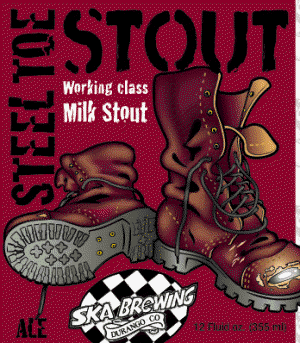 Ska Steel Toe Working Class Milk Stout Top Tastings 2012
ABV: 5.4%
Origin: Durango, Colorado, USA
Website: www.skabrewing.com
With my soft spot for the smarter and sharper side of mid-1960s music and fashion and its later revivalist derivatives, I was intrigued to find a Colorado craft brewery calling itself Ska and borrowing its imagery unashamedly from the design vocabulary of 2-Tone Records.
In the cartoon art on their website, former home brewers Bill Graham, Dave Thibodeau and Matt Vincent, who founded Ska in 1995, appear in the standard issue US craft brewers’ uniform of T-shirts, baggy shorts and baseball caps. So I’m not quite sure how they’ve come to reference a largely working class youth culture movement from the English West Midlands in the late 1970s, which itself drew on an even more proletarian youth cult of the previous decade with a somewhat violent reputation.
Still, the graphics look great, the humour engaging, and the product is unquestionably excellent. I’d had several Ska beers before, but Steel Toe, which I bought in a bottle from the pioneering craft beer list at a branch of London independent gourmet burger bar chain Byron, was the first one that moved me to write about it.
It’s particularly interesting as an example of a revival of a threatened style, milk stout, which uses lactose, an unfermentable sugar derived from milk, to add sweetness and texture to the finished beer. Ska’s beautifully balanced example is a near-black beer with a ruby tinge and a creamy, light beige head.
The aroma is dark, malty and sweetish, with a creamy and very toothsome palate, sweet and slightly treacly but dried by roast notes, and revealing deeper layers of ripe fruit, toffee apple, leather and moist cake. A soft swallow leads to a tasty lightly drying finish with rounded, burry hops and a hint of ashy roast.
You have to raise your eyebrow at the name – skinheads shod in steel toed Doctor Martens would surely have regarded milk stout as the sort of drink their grannies liked.
 Shepherd Neame Double Stout Top Tastings 2012 (India Pale Ale)
ABV: 5.2% and 6.1%
Origin: Faversham, Kent, England
Website: www.shepherd-neame.co.uk
When I was rediscovering beer back in the mid-1990s, one of my favourites was bottle conditioned Shepherd Neame Spitfire, regularly available in my local supermarket. Its classic combination of rich malts and moist, sacky and earthy English hops struck me as just what a proper beer from one of Britain’s most important historic hop growing regions should taste like.
The brewery, right in the middle of the pretty little town of Faversham in marshy country by the Swale, even has hop cones picked out in plaster pargeting on the brewery walls, and back then its beers were widely admired. But over the years since, its range seemed to have got blander and more conservative. Cask Spitfire became a less distinctive national brand, supported by World War II-inspired adverts in dubious taste, while the bottled version was unsympathetically pasteurised into a lifeless boiled sweet beer.
Sheps drew further criticism from connoisseurs for its insistence on using clear glass bottles, even claiming that some customers preferred the resulting light struck ‘skunked’ quality. It had seemingly become more interested in its roster of generally indifferent international lager brands brewed under license – Asahi, Hürlimann, Kingfisher, Oranjeboom, and recently Samuel Adams – than in ensuring the distinctiveness of its ales.
But recently there are signs that things are in Faversham are looking up. A new head brewer, Richard Frost, joined from Marston’s late in 2011. Generation Ale, a big dark barley wine that, while certainly ambitious and distinctive, didn’t quite cohere enough to justify its strength or price, appeared shortly afterwards. The brewery then keenly supported 2012’s inaugural Kent Green Hop Fortnight championed by Ramsgate craft brewer Eddie Gadd.
Late in 2012 I was asked to compile a list of the 100 most important British brewers for an international guide. I was actually hesitating on whether or not to include Sheps – and what finally swayed me in its favour was the arrival of two rather special sample bottles indicating that the brewery was now finding strength in its lengthy heritage.
Brewery historian John Owen and brewer Stewart Main dug through 19th century brewers’ logs, may of them written in code, to create two new heritage beers. Both were presented with handsomely Victorian label designs and – even better – in traditional amber bottles.
Double Stout, based on an 1868 recipe, was created from pale, roasted, crystal and chocolate barley malts and kilned roasted barley using the brewery’s oak mash tuns, the last in use in the UK. The result was a glossy near-black beer with a thick and bubbly tan head and an aroma of wood smoke and coffee with flowery and mineral notes.
A thick old fashioned fruit cake palate had notes of burnt raisins, coffee and plain chocolate with some sweet fruit. The long and very pursing finish derived most of its burnt toast bitterness from roasted grain, but with a flourish of burry hedgerow hop notes – from East Kent Goldings, naturally enough.
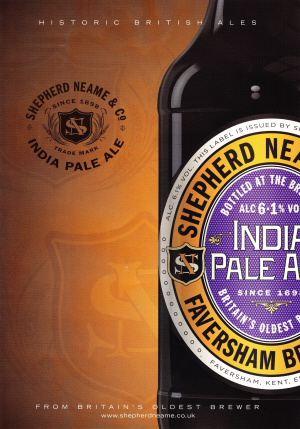 Shepherd Neame India Pale Ale Note by the way that this is a different beer from a 4% so-called Double Stout produced by the brewery a few years back in cask and bottle.
East Kent Goldings also featured alongside Fuggles in an India Pale Ale derived from an 1870 recipe, which to me just had the edge over the stout. This was an orangey amber colour with a fine creamy yellow head and a beautifully rich and seedy hoppy aroma. A touch of nutty sweetness also coloured the nose alongside cream, an intriguing sulphur touch and a very faint hint of butter.
The palate was deliciously smooth, fruity and peppery, with generous stewed hop resins, cracked pepper, orange, cream and honeycomb flavours. A very authentic earthy hop finish built in bitterness alongside pursing fruit.
The IPA is particularly welcome as a fine example of a genuinely English interpretation of the style. The revival of interest in IPAs at the strengths and hop concentrations of the original versions exported from Britain to the Indian subcontinent in past centuries has of course been one of the most significant trends on the brewing scene in recent years. But these days genuinely big and hoppy IPAs from British brewers tend to turn to the US, where the revival began, for inspiration and hop supplies.
And while I’ve grown to love the lively flavours of modern American hop varieties, in the interests of diversity and variety rather than jingoism it’s good to taste a beer that exclusively employs venerable English varieties like Fuggles and Goldings to the same level of assertiveness. It’s also, of course, likely to be closer to the flavour of IPAs of the past.
And yes, I’m aware that British brewers were using hops from the Pacific Northwest and other parts of North America right back in the 19th century. But I doubt the flavours and aromas of the day were anything like as vivid and assertive as those of modern varieties, particularly if they’d spent months in unrefrigerated transit.
Shepherd Neame has a good claim to being Britain’s oldest brewery in continuous operation – its official founding date is 1698 though there is some evidence that brewing on the site stretches back up to 150 years before that. So it has a rich vein of heritage to draw on. I look forward to seeing the fruits of further raids on the archives.
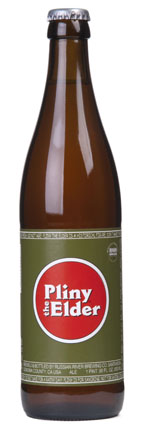 Russian River Pliny the Elder Top Tastings 2012
ABV: 8%
Origin: Santa Rosa, California, USA
Website: www.russianriverbrewing.com
Russian River brewer Vinnie Cilurzo is generally credited with creating the Double IPA as a commercial beer style. Inaugural IPA, the first beer Vinnie brewed professionally, was so named as it launched his first brewing venture, Blind Pig at Temecula, California, in June 1994. But as it turns out, it also inaugurated a slew of ultra-hoppy West Coast pale ales that turned out to be arguably as influential internationally as the original British India Pale Ales had been in their day.
There were enough double IPAs around by 2001 for the Bistro restaurant in Hayward, California, to stage a whole festival dedicated to the style, involving 10 brewers. Vinnie had since moved to Russian River, and devised a new beer for the festival. It was named after Roman naturalist and naval commander Pliny the Elder, or Gaius Plinius Secundus, killed in the famous eruption of Vesuvius in 79 that also engulfied Pompeii. His book Naturalis Historia contains – possibly – the earliest known written mention of hops.
So Pliny the Elder isn’t itself the first Double IPA, but it certainly has an authentic pedigree. It’s also become one of the most celebrated beers in the style, regularly figuring in the upper reaches of Top 10 lists and winning several awards.
As I’ve described elsewhere, Pliny was my first taste of US craft beer on US soil when I sampled it on cask at the Russian River brewpub in Santa Rosa in 2005. In retrospect it probably wasn’t the best introduction. Even many of its fans would agree it’s hardly the best gateway beer for a palate still unaccustomed to the flavour spectrum of West Coast pales. And I’ve since concluded that cask conditioning is not the format in which such brews best express themselves – they need the extra sparkle trapped in a bottle or keg to help them sing.
At the time I noted a slightly cloudy pale golden ale, with only a little white lace for a head and a sweet aroma of glycerine, jasmine and pineapple. A thick and furry palate had pineapple, geranium, pine, leather and sacky notes. A bitter swallow led to a long and massively intense pine, pepper and fruity hop finish that puckered like strong tea.
Since then I’ve drunk many more big, strong, hoppy pale ales from the US and elsewhere and my palate is better calibrated to their pleasures. But other than that first cask encounter I hadn’t yet returned to Pliny. I put that right in October 2012 by picking up a bottle at Best Damn Beer Shop in San Diego.
This time the golden colour was much more attractively set off with a rich white head. The aroma was still thick and strong – I noted peach, fresh flowers, citrus and gunpowder. A resinous, tannic and vividly hoppy palate had peach fruit striated with lemon balm, and emerging flavours of mint, pine, fresh grass and creamy malt.
A very long and slowly unfolding finish saw pine and tannins coming to the fore, offset by coating and creamy malt, with plenty of spice and a late fresh pepper note. Though describing the hop character of the beer as assertive seems something of an understatement, it remained perfectly composed, taking time to tell its long and complex story of flavour.
This is a beer that asks you to drink it fresh, displaying the date on the bottle, so I was glad to see mine was no more than a month old. Reconsidering it on a more flattering platform, I agree that it deserves its high reputation as one of the best exemplars of the style – if not the ideal one to serve up first to a naïve mild drinker from London.
|
Cask  This pioneering new book explains what makes cask beer so special, and explores its past, present and future. Order now from CAMRA Books. Read more here. This pioneering new book explains what makes cask beer so special, and explores its past, present and future. Order now from CAMRA Books. Read more here.
London’s Best Beer  The fully updated 3rd edition of my essential award-winning guide to London’s vibrant beer scene is available now from CAMRA Books. Read more here. The fully updated 3rd edition of my essential award-winning guide to London’s vibrant beer scene is available now from CAMRA Books. Read more here.
|

















